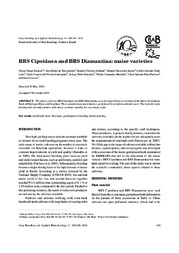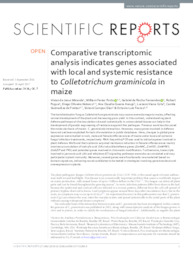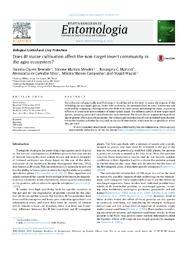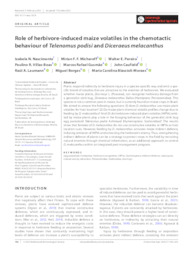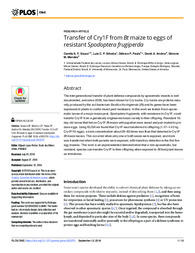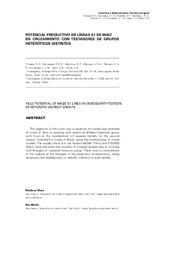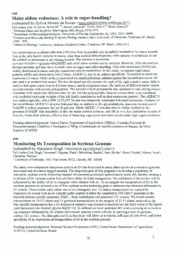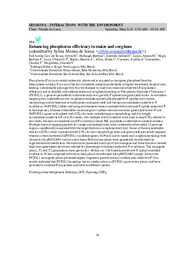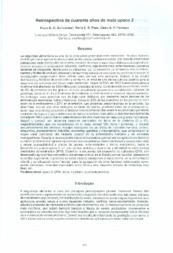Busca de Publicações
Filtrar por:
| Autoria: RIOS, S. de A.; PAES, M. C. D.; BORÉM, A.; CRUZ, C. D.; GUIMARAES, P. E. de O.; SCHAFFERT, R. E.; CARDOSO, W. S.; PACHECO, C. A. P. The purpose of this study was to investigate the adaptability and stability of carotenoids in maize cultivars in the 2004/2005 growing season. Total carotenoids (TC), total carotenoids with provitamin... ... |
| Autoria: TEIXEIRA, F. F.; VASCONCELLOS, J. H. de; ANDRADE, R. V. de; SANTOS, M. X. dos; LEITE, C. E. P.; GUIMARAES, P. E. de O.; PARENTONI, S. N.; MEIRELLES, W. F.; PACHECO, C. A. P.; CECCON, G. The maize cultivars BRS Cipotânea and BRS Diamantina were developed from accessions of the Maize Germplasm Bank of Embrapa Maize and Sorghum. The evaluation was participative, performed by scientists... ... |
| Autoria: MIRANDA, V. de J.; PORTO, W. F.; FERNANDES, G. da R.; POGUE, R.; NOLASCO, D. O.; ARAUJO, A. C. G.; COTA, L. V.; FREITAS, C. G. de; DIAS, S. C.; FRANCO, O. L. The hemibiotrophic fungus Colletotrichum graminicola may cause severe damage to maize, affecting normal development of the plant and decreasing grain yield. In this context, understanding plant defens... ... |
| Autoria: RESENDE, D. C.; MENDES, S. M.; MARUCCI, R. C.; SILVA, A. de C.; CAMPANHA, M. M.; WAQUIL, J. M. The cultivation of genetically modified crops in Brazil has led to the need to assess the impacts of thistechnology on non-target species. Under field conditions, the potential effect on insect biodiv... ... |
| Autoria: NASCIMENTO, I. N.; MICHEREFF, M. F. F.; PEREIRA, W. E.; BOAS, P. R. V.; GUSMAO, M. R.; CAUFIELD, J.; LAUMANN, R. A.; BORGES, M.; MORAES, M. C. B. Plants respond indirectly to herbivore injury in a species-specific way and emit a specific blend of volatiles that are attractive to the enemies of herbivores. We evaluated whether maize plants, Zea... ... |
| Autoria: SOUZA, C. S. F.; SILVEIRA, L. C. P.; PAULA, D. P.; ANDOW, D. A.; MENDES, S. M. The intergenerational transfer of plant defense compounds by aposematic insects is well documented, and since 2006, has been shown for Cry toxins. Cry toxins are proteins naturally produced by the soi... ... |
| Autoria: TRINDADE, R. dos S.; GUIMARAES, P. E. de O.; MEIRELLES, W. F.; MACHADO, J. R. de A.; PACHECO, C. A. P.; GUIMARAES, L. J. M.; TARDIN, F. D.; SILVA, A. R. da The objective of this work was to evaluate the productive potential of maize S1 lines in crossing with testers of different heterotic group, with focus in the development of superior hybrids for the s... ... |
| Autoria: SOUSA, S. M. de; KIYOTA, E.; YUNES, J. A.; KOCH, K. E.
|
| Autoria: SOUSA, S. M. de; HUFNAGEL, B.; AZEVEDO, G. C.; LOPES, S. M.; NEGRI, B. F.; LANA, U. G. P.; BARROS, B. A.; ALVES, M. C.; CARNEIRO, A. A.; GUIMARÃES, C. T.; MAGALHAES, J. V.
|
| |
Observações
1 - Por padrão são exibidas publicações dos últimos 20 anos. Para encontrar publicações mais antigas, configure o filtro ano de publicação, colocando o ano a partir do qual você deseja encontrar publicações. O filtro está na coluna da esquerda na busca acima.
2 - Para ler algumas publicações da Embrapa (apenas as que estão em formato ePub), é necessário ter, no celular ou computador, um desses softwares gratuitos. Sistemas Android: Google Play Livros; IOS: iBooks; Windows e Linux: software Calibre.
Acesse outras publicações
Acesse a Base de Dados da Pesquisa Agropecuária (BDPA) para consultar o acervo completo das bibliotecas da Embrapa.


